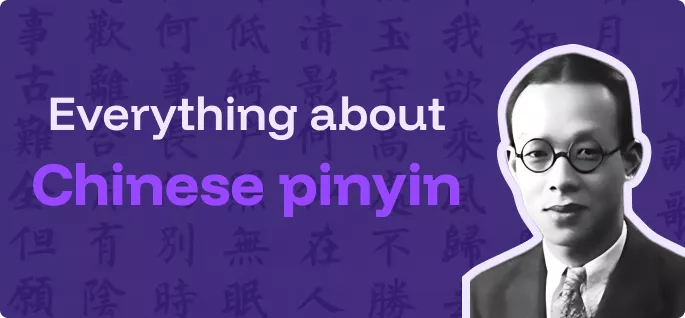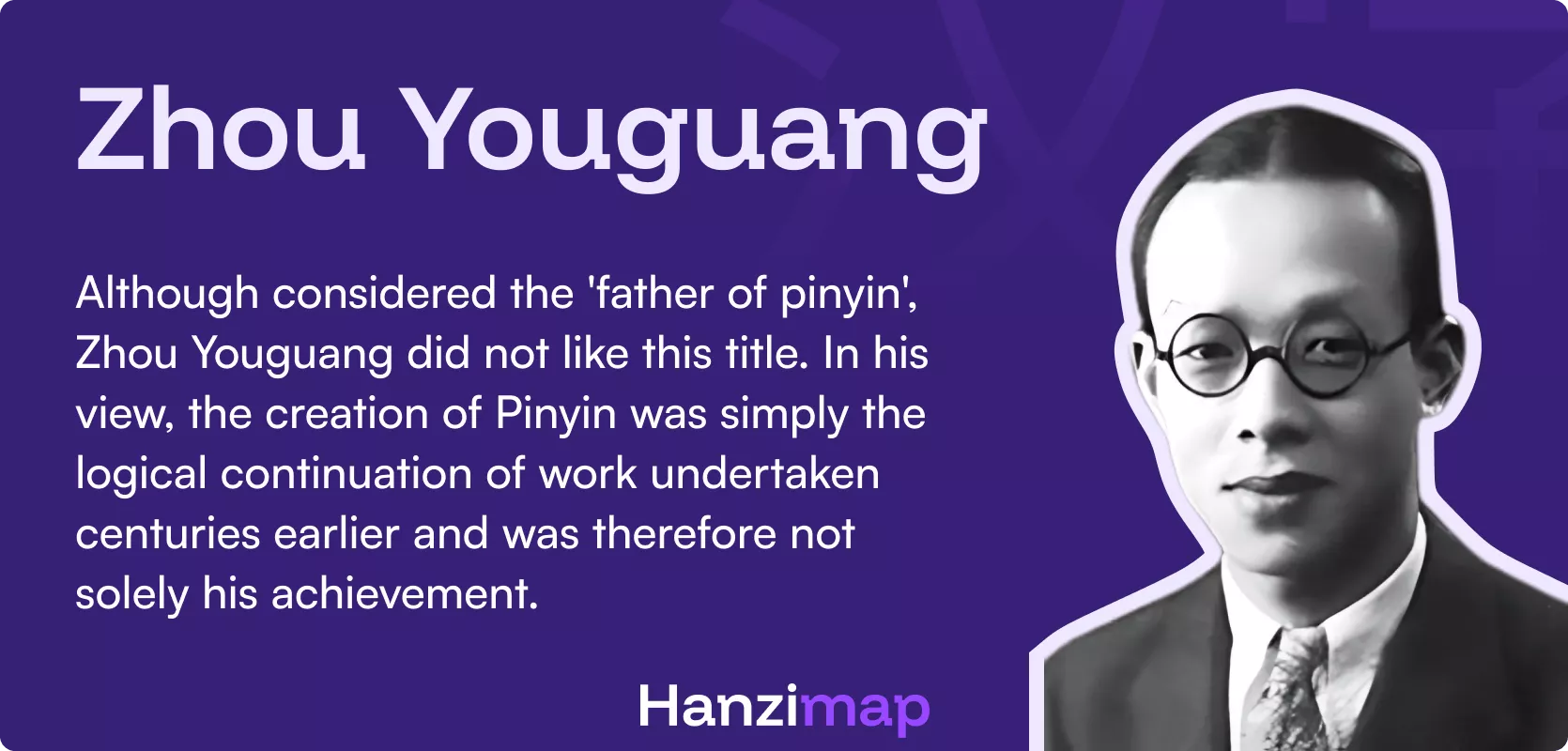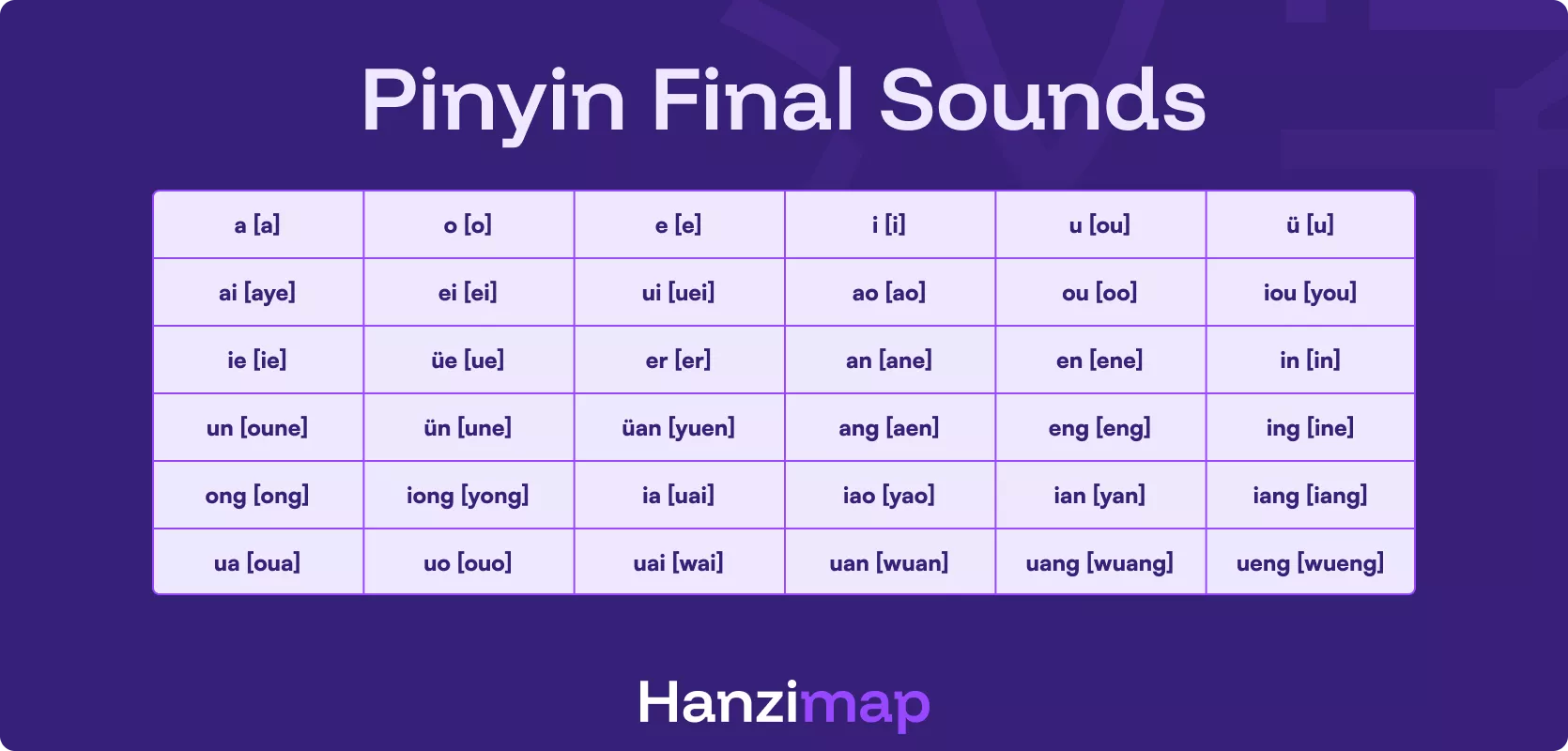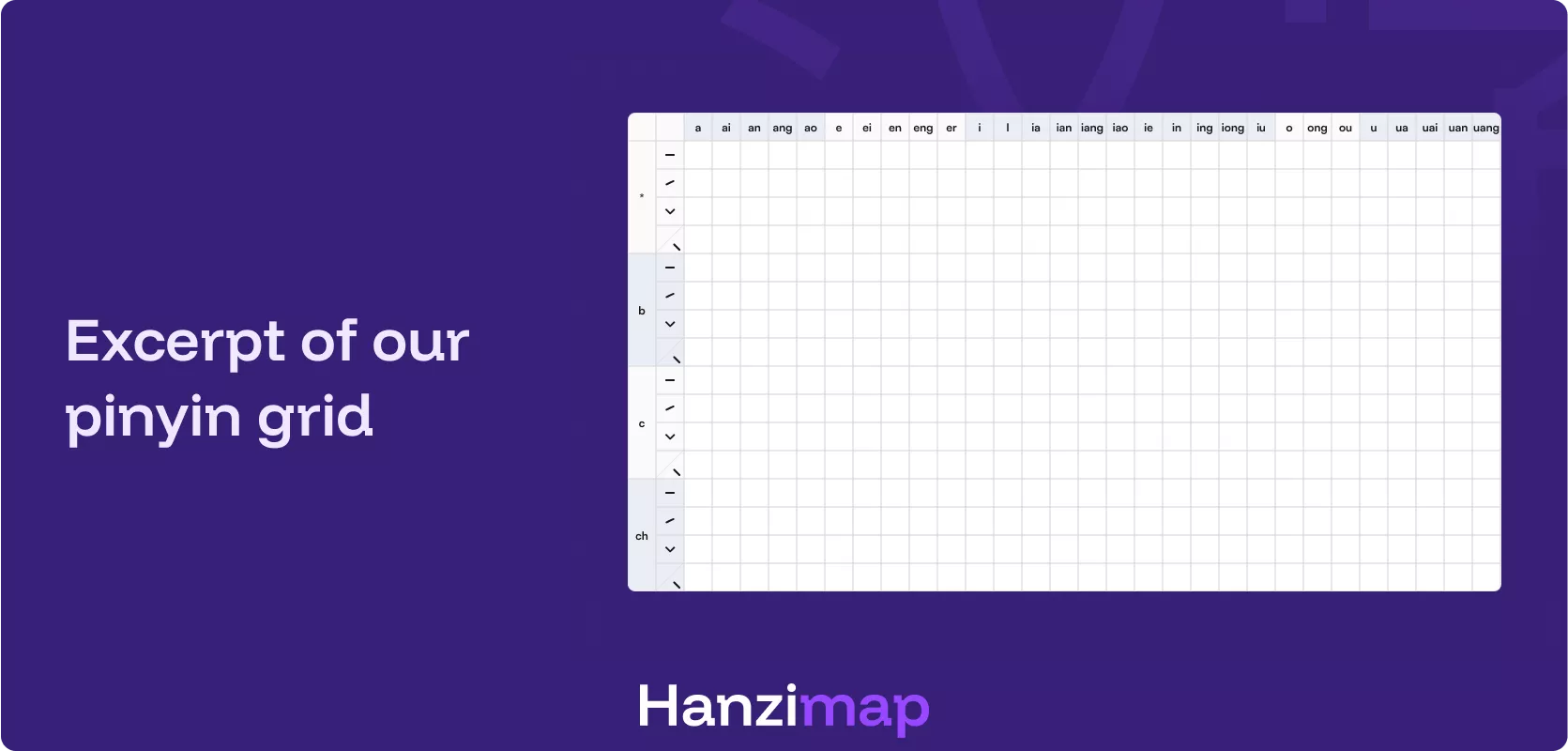
Discover Pinyin, Mandarin's reference romanization system to learn how to pronounce Chinese

Découvrez notre nouvelle méthode d’apprentissage
Hanzimap la plateforme intuitive et visuelle pour apprendre le chinois pas à pas, en comprenant la logique des caractères.

Learn Pinyin with Hanzimap
With Hanzimap, you can learn Pinyin in a fun way and make progress without even realising it.

If you're learning Chinese, you've probably run into a major hurdle very quickly: pronunciation. And in the face of characters far removed from what You are used to, that's understandable! What if we told you that there is a tool that will make your job easier? Its nickname: pinyin.
An official romanization system for Mandarin, Pinyin allows you to Transcribe the sounds of Chinese with the Latin alphabet, thus helping you pronounce this language, even if you don't know a single Hànzì.
In this comprehensive guide, you'll learn everything you need to know about Chinese pinyin, how it works and how to use it. As a bonus, you will also discover Hanzimap, an innovative tool thanks to which you can learn to use it while having fun!
What is pinyin?
If you've ever wanted to learn to speak Chinese, you know how difficult it can be to remember all of its characters (also called Hànzì), and especially their pronunciation. And it is precisely to alleviate this problem that Hanyu Pinyin was invented.
Literally, “pinyin” (or “拼音” in Mandarin) means “assembling sounds.” And to put it simply, Chinese pinyin Refers to a Mandarin Romanization System. In other words, it is a method that uses the Latin alphabet to transcribe the sounds of Chinese. You can almost think of it as a kind of Chinese alphabet for phonetic. The interest? It becomes much easier to pronounce and read them, even if you don't know the Hànzì that are normally used to transcribe them!
And while this phonetization system helps foreigners a lot, it is also a great help for native speakers, since it is taught at school in China, but also used to alphabetize adults who cannot read and/or write.
The benefits of learning Hanyu Pinyin
If this method has even been officially adopted by the Chinese government, it is because pinyin has many advantages. For example, it allows you to:
- To read Mandarin aloud, even if you don't know the Chinese characters.
- To pronounce words easily and correctly thanks to the romanization of syllables.
- To memorize the famous tones, so feared by foreigners, but which are essential for understanding.
- To type in Chinese on a computer or smartphone.
In short, Pinyin helps you learn to speak Chinese correctly by offering you a faithful and legible transcription of the Chinese characters.
A short history of Pinyin: from attempts to romanize Chinese to the educational tool we know today
For many, Zhou Youguang is considered to be the father of pinyin. But in fact, he himself had a hard time accepting this title. First, because he did not develop this approach alone, but with a group of linguists. But above all, according to Zhou Youguang, the invention of pinyin is only the logical continuation of the work already begun in previous centuries.
The first methods of romanizing Chinese emerged as early as the 17th century. But they were mostly developed by foreigners who wanted to spread the Chinese language in their own countries, or even import their own culture into China. Over the years, several romanization systems have thus emerged:
- 1605: publication of Xizi Qiji by the Jesuit Matteo Ricci.
- 1859: birth of the Wade-Giles system, which remained popular with English speakers until 1979.
- 1902: design of the EFEO system (École française d'Extrême-Orient), designed especially for French-speaking learners.
- Years 1930-40: development of Sin Wentz by members of the Chinese Communist Party who studied in Moscow. Originally designed to make the Russian Far East literate, this system was approved by some leaders such as Mao Zedong. Many were looking forward to its official adoption with the Chinese government. This never happened, in particular because this system was not adapted to regional languages, and it gradually fell into disuse.
- 1943: Very similar to what pinyin is today, the Yale system was developed by the university of the same name for American pilots flying over China. What's the main difference between Pinyin and Pinyin? Phonetic transcription was more suitable for English speakers.
For several decades, different systems have thus coexisted. But they were neither unified nor standardized, to the extent that they sometimes gave the impression of dealing with a different language. Hanyu Pinyin thus emerged at a pivotal moment, when it was necessary to find a system of linguistic standardization that would benefit both native speakers and foreigners.

How does Pinyin work?
Now that you have a better understanding of what pinyin is for, let's see how it works. For starters, you can think of Pinyin as a kind of Chinese phonetic alphabet, and remember that each Pinyin syllable consists of three components:
- An initial (there are 23, which are generally consonants).
- A final (there are 36).
- A tone, or tonal accent, that determines the pronunciation of the syllable and therefore its meaning (there are 4).
Initials: consonants and semivowels
Each syllable starts with an initial, which is most often a consonant, and sometimes a semivowel. There are 23 in total, which you will find with their pronunciations in the following table:

The finals: the vowels
Then comes the final. They can be “simple” vowels (there are 6) or combined (there are 30). You will find them all in the following table:

The tones (or tonal accents)
Putting together an initial and a final is not enough to form a syllable, and for a simple reason: this combination could be pronounced in many different ways! The decisive factor? The tonal accent, or tone. There are 4 (plus a neutral tone), and they are the ones that give Mandarin its particular musicality.
But these tones are also scary for many newbies, and it's not hard to see why: they can totally change the meaning of a word. Imagine for a moment being in the middle of a cordial conversation, pronouncing a word incorrectly, and finding yourself insulting your interlocutor by accident... This is indeed scary 😅
To help you, Pinyin indicates tones with diacritics (or accents if you prefer). You can discover them in the following table:

In short: how do you pronounce Mandarin using the Chinese phonetic alphabet?
Good news: now that you know the three essential ingredients for forming a syllable, you are able to read and pronounce Mandarin correctly, even if you don't know any Chinese characters. Magical, no?
But let's take an example to make it really concrete, and let's say you want to say “mom.” For this:
- The initial will be “m”,
- The final will be “a”,
- And you'll have to use the first tone: “ā”
- So this gives: “mā”
And let's play with tonal accents so you can fully understand their importance:
- So with the first accent, we have the word “mom”: “ma”
- With the second accent, we get the word “hemp”: “má”
- With the third accent, “horse”: “m”
- With the fourth accent, “to scold, to insult”: “to me”
- With the neutral tone, you get “ma”, an interrogative particle that is used to mark a question
A poorly stressed syllable can therefore completely change the meaning of a sentence, which could sometimes put you in delicate situations, for example if you called your mother “horse” instead of “mom” 😅 And if for you, the difference in pronunciation will be subtle, it will not escape a Chinese person!
Learn Pinyin easily with Hanzimap
In theory, to pronounce Chinese words in the right way, all you have to do is learn their version in Pinyin. In practice... things are a bit more complicated than that.
Certainly, you could try the classic method: try to memorize lists of syllables by heart, repeating each word over and over again until it stays stuck in your memory.
But let's be honest: memorization by repetition Quickly reaches its limits. The further you go, the more the syllables end up looking alike, and the more likely you are to Mix everything. Over time, your memory sessions may even turn into ineffective chores...
And it is precisely to alleviate this problem that we created Hanzimap, an innovative visual approach that will help you assimilate Chinese Pinyin easily. But how does that work?
It all starts with the Hanzimap grid, where every word can be represented. Here it is:

Then all you have to do is connect the initial to its final and tone, and you have the visual signature of the word you are looking to remember! The interest? This spatial arrangement creates a word signature that your brain can naturally remember. Think of it as visual fingerprints that are specific to each word, easy to recognize, and therefore easy to remember! So see here, with the words “swim” and “pool”:

- Alone, 游 (You in Pinyin) can mean “swimming,” “sightseeing,” or “sightseeing.”
- Associated with 泳 (Yong), you get 游泳 (Youyong) It means “to swim.”
- And by adding to 池 (Chi), you get 游泳池 (Youyongchia) which means “pool.”
- But remembering these combinations can be complicated, and that's where Hanzimap is useful: you remember the layout of each character in the grid, and the” signature ” words, symbolized by arrows, easier to remember and thanks to which you can easily assemble the right characters.
Result? With Hanzimap, you learn to pronounce words correctly, but above all, you build strong reading reflexes that will help you make rapid progress. A tool to adopt without delay, therefore, if you need help to achieve your linguistic goals, and for example to prepare for HSK exam ! So what are you waiting for to try Hanzimap?
Can you just learn Pinyin to speak Chinese?
Pinyin is a wonderful gateway to Chinese, as it allows you to pronounce words correctly for a simple conversation, even if you've only been practicing for a few weeks. However, if you really want to make progress, you won't be able to just learn Pinyin.
Pinyin is only a romanization tool, and as a result, it does not allow you to read or write Mandarin using Chinese characters. The problem is that if you want to take your learning a step further, the resources available will rarely be available in Pinyin. Likewise, if you travel to China, you will have a hard time getting by without knowing the Hànzì.
You can therefore use pinyin to make yourself understood orally, but you will quickly be limited as soon as you want to read a menu, send a message, or even simply understand a text. Pinyin is therefore complementary to characters, but cannot replace them in any way. And in reality, one does not go without the other.

If you are just starting out, Pinyin is essential as it will help you develop your comprehension and speaking skills. But if you really want to progress, it is interesting to combine your learning with that of the Hànzi.
And that's exactly where a tool like Hanzimap can be of great help to you. By using it, you will gradually learn to associate pinyin with the corresponding hànzì, and will thus progress at your own pace, and in a fun way.
Frequently asked questions about Pinyin
How do I write in Pinyin on Mac?
To write in Pinyin on a Mac, follow these steps:
- Open System Preferences.
- In the sidebar, select “Keyboard.”
- In the “Text Input” window, to the right of “Input Methods” click on “Edit...”.
- In the window that opens, at the bottom left, click on the “+”.
- Select “English”, then choose “ABC - Extended” and then click “Add.”
- To switch to this pinyin keyboard, all you have to do is press the globe key, usually at the bottom left.
- You can indicate tonal accents by pressing and holding the corresponding vowel; a window will then be displayed, and you can select the correct accented letter.
How do you write in Pinyin on your phone?
- On iOS, go to your settings, then to “General”, “Keyboard”, click on “Keyboard” at the top of your screen, then on “Add a keyboard.” Then type “pinyin”, and choose between AZERTY and QWERTY keyboards.
- On Android, the easiest way is to install a third-party application like “Chinese Keyboard - Pinyin”.
What is the link between Pinyin and Hànzi?
Hànzì are Chinese characters, while Pinyin is a romanization system that allows these hànzì to be transcribed using the Latin alphabet. These two systems are therefore complementary, since pinyin allows you to pronounce the hànzi correctly, and therefore to improve your speaking skills.
Other items you might like

Discover Pinyin, Mandarin's reference romanization system to learn how to pronounce Chinese

How to learn Mandarin Chinese on your own? Our 13 tips for making rapid progress



